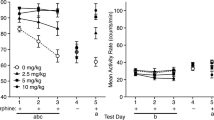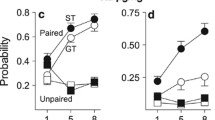Abstract
The discriminative stimulus effects of centrally administered morphine were characterized in rats trained to discriminate 3.0 mg/kg SC morphine from saline in a two-choice discrete-trial avoidance paradigm. The intracerebroventricular (ICV) administration of 0.3–10 μg morphine engendered morphine-appropriate responding, morphine administered ICV being nearly 1000 times as potent as morphine administered SC. Cannula implantation itself did not affect the sensitivity of the rats to the discriminative effects of morphine. The onset of the discriminative stimulus effects of ICV morphine was not immediate; stimulus generalization comparable to that produced by 3.0 mg/kg morphine occurred 30–60 min after the injection of 1.0 or 10 μg ICV morphine and persisted for 90 and 150 min, respectively. Naltrexone blocked the discriminative stimulus effects of 10 μg ICV morphine in a dose-related manner. Complete antagonism of the stimulus effects of this dose of morphine was obtained with 0.01–0.03 mg/kg SC naltrexone. When administered centrally, the relatively lipid insoluble naltrexone methobromide completely antagonized the discriminative effects of 3.0 mg/kg morphine at a median effective dose of 0.3 μg. In contrast, when injected systemically at a dose of 1.0 mg/kg (approximately 500 μg), naltrexone methobromide failed to block the discriminative stimulus effects of either 10 μg ICV morphine or the SC training dose. Thus, periventricular brain sites appear to be involved in mediating the discriminative stimulus effects of morphine in the rat.
Similar content being viewed by others
References
Brown DR, Robertson MJ, Goldberg LI (1983) Reversal of morphine-induced catalepsy in the rat by narcotic antagonists and their quaternary derivatives. Neuropharmacology 22:317–321
Brown DR, Goldberg LI (1985) The use of quaternary narcotic antagonists in opiate research. Neuropharmacology 24:181–191
Browne RG, Fondren B (1978) β-endorphin and the narcotic cue. In: Colpaert FC, Rosecrans JA (eds) Stimulus properties of drugs: Ten years of progress. Elsevier/North Holland, Amsterdam, pp 137–147
Chipken RE, Stewart JM, Morris DH, Crowley TJ (1978) Generalization of (D-Ala2)-enkephalinamide but not of substance P to the morphine cue. Pharmacol Biochem Behav 9:129–132
Colpaert FC, Lal H, Niemegeers CJE, Janssen PAJ, Van Ree JM (1978) Narcotic cueing properties of intraventricularly administered sufentanil, fentanyl, morphine and met-enkephalin. Eur J Pharmacol 47:115–119
Herling S, Woods JH (1981) Discriminative stimulus effects of narcotics: Evidence for multiple receptor-mediated actions. Life Sci 28:1571–1584
Herz A, Teschemacher HJ (1971) Activities and sites of antinociceptive action of morphine-like analgesics. Adv Drug Res 6:79–119
Holtzman SG (1983) Discriminative stimulus properties of opioid agonists and antagonists. In: Cooper SJ (ed) Theory in psychopharmacology, vol 2. Academic Press, New York, pp 1–45
Lal H, Gianutsos G, Miksic S (1977) Discriminable stimuli produced by analgesics. In: Lal H (ed) Discriminative stimulus properties of drugs. Plenum Press, New York, pp 23–45
Severs WB, Summy-Long J (1976) The role of angiotensin in thirst. Life Sci 17:1513–1526
Shannon HE, Holtzman SG (1976a) Evaluation of the discriminative stimulus effects of morphine in the rat. J Pharmacol Exp Ther 198:54–65
Shannon HE, Holtzman SG (1976b) Blockade of the discriminative effects of morphine in the rat by naltrexone and naloxone. Psychopharmacologia 50:119–124
Shannon HE, Holtzman SG (1977) Discriminative effects of morphine administered intracerebrally in the rat. Life Sci 21:585–594
Valentino RJ, Herling S, Woods JH, Medzihradsky F, Merz H (1981) Quarternary naltrexone: evidence for central mediation of discriminative stimulus effects of nacrotic agonists and antagonists. J Pharmacol Exp Ther 217:652–659
Valentino RJ, Katz JL, Medzihradsky F, Woods JH (1983) Receptor binding, antagonist, and withdrawal precipitating properties of opiate antagonists. Life Sci 32:2887–2896
Author information
Authors and Affiliations
Rights and permissions
About this article
Cite this article
Locke, K.W., Holtzman, S.G. Characterization of the discriminative stimulus effects of centrally administered morphine in the rat. Psychopharmacology 87, 1–6 (1985). https://doi.org/10.1007/BF00431767
Received:
Accepted:
Issue Date:
DOI: https://doi.org/10.1007/BF00431767




